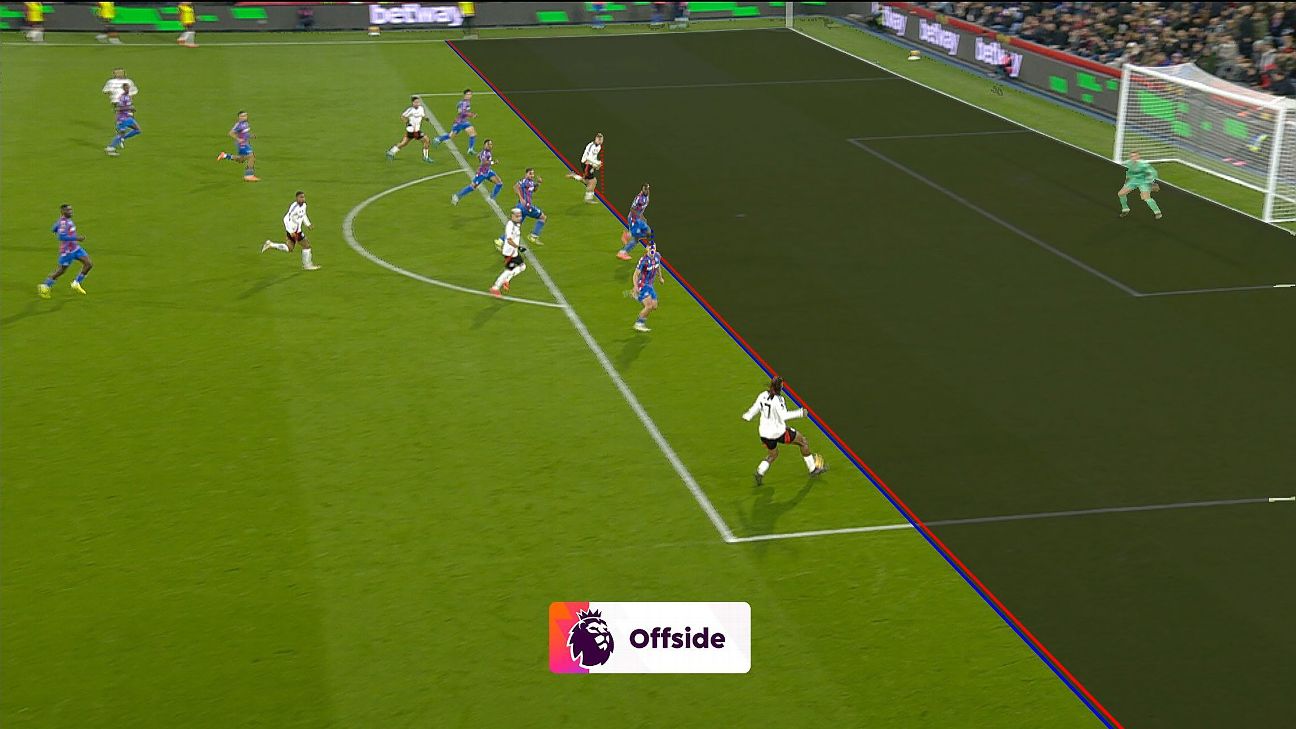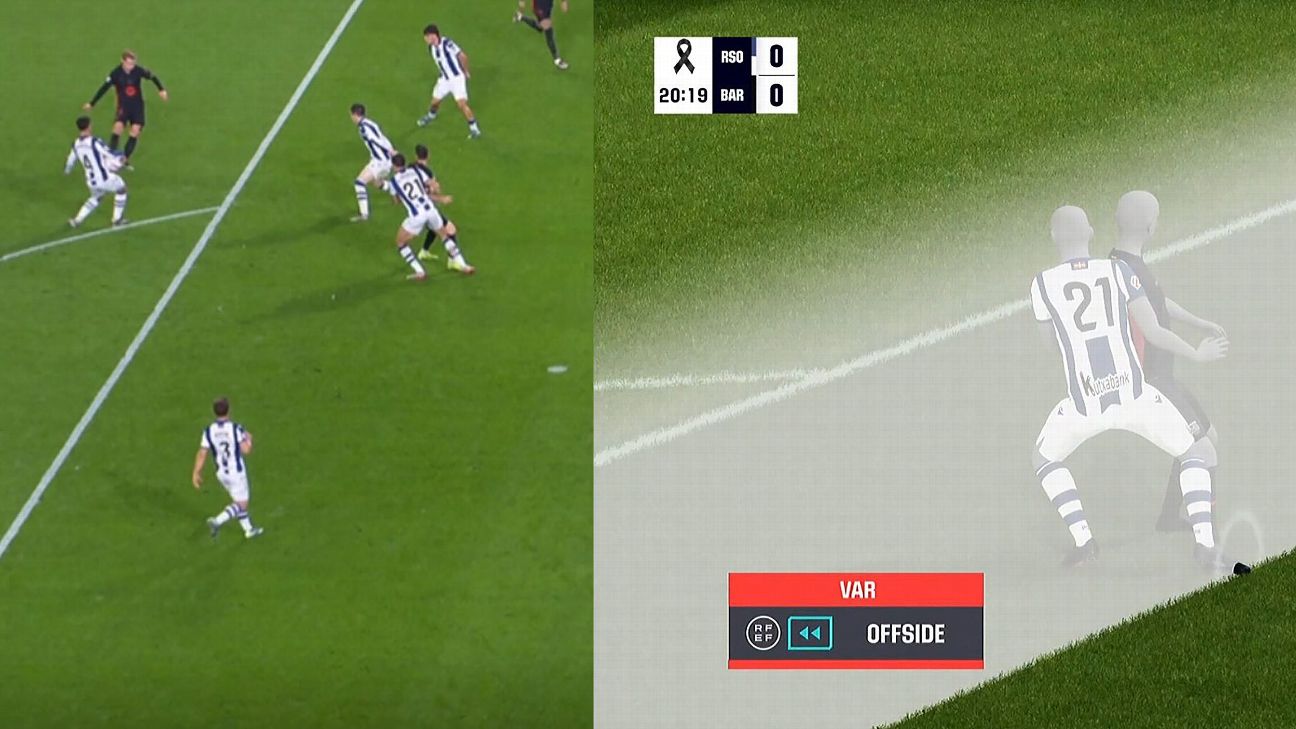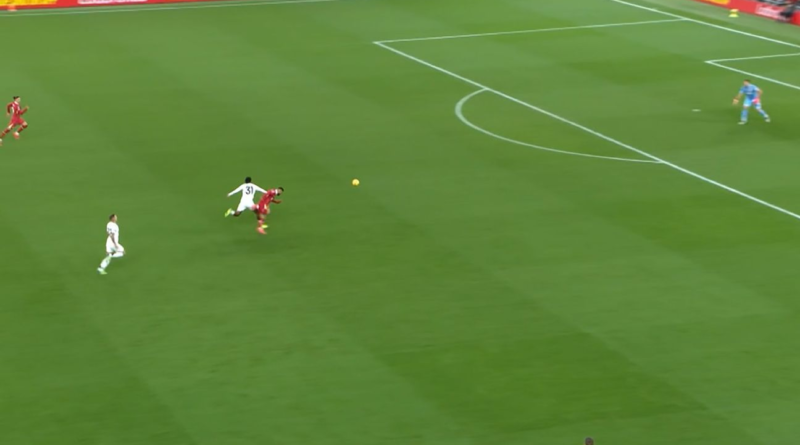VAR Review: Should Bailey have been sent off?
Video Assistant Referee causes controversy every week in the Premier League, but how are decisions made, and are they correct?
After each weekend, we take a look at the major incidents to examine and explain the process, in terms of VAR protocol and the Laws of the Game.
In this week’s VAR Review: Should Aston Villa have been reduced to 10 men against Liverpool? Why Southampton have every right to feel hard done by in their defeat at Wolverhampton Wanderers. And how semiautomated offside technology has hit issues in LaLiga.
Possible DOGSO red: Bailey challenge on Salah
What happened: Liverpool broke on the counter-attack in the 20th minute, with Leon Bailey giving chase to Mohamed Salah before appearing to bring down the Egypt international as he was through on goal. Referee David Coote signalled there had been no foul, and Darwin Núñez ran onto the loose ball to score the opening goal. But how does the law work with the challenge on Salah for denying an obvious goal-scoring opportunity (DOGSO), was an advantage played, and what disciplinary action could have been taken through VAR?
VAR decision: No red card.
VAR review: Until a controversial incident in the 2006 Champions League final, it wasn’t expressly said that a player shouldn’t be sent off if they committed a DOGSO offence before a goal had been scored. Arsenal goalkeeper Jens Lehmann brought down Barcelona‘s Samuel Eto’o outside the area, but before Ludovic Giuly could roll the ball into an empty net referee Terje Hauge stopped play and produced the red card.
Hauge said after the game that he wished he had waited, given the goal and only booked Lehmann. While it’s true that Hauge should have delayed his whistle to allow Giuly to score what was a certain goal (Barcelona instead got only a free kick), until this point the law said Lehmann should still get a DOGSO red card even if there had been a goal.
The incident led to a clarification of the law, and the removal of a DOGSO red card in such circumstances — the logic being that if a team have scored a goal, it would be unfair to penalise a player for denying a scoring chance.
So, Núñez scoring meant that the decision was taken out of the VAR’s hands for anything other than a possible offence by the goal scorer.
It appeared to be a clear foul on Salah, yet Coote did not play the advantage. The scoring chance for Núñez needed to be far more certain for a referee to play an advantage on a red-card situation, like when Giuly had an empty goal in front of him. If Coote had played advantage, he should have booked Bailey, regardless of whether Núñez had scored. And as the VAR cannot get involved in missed yellow cards, VAR Paul Tierney would not have been able to review the challenge.
However, had Núñez shot wide or seen his effort saved, that would have brought the VAR into play. When a goal hasn’t been scored, the DOGSO offence belongs to the player (Salah) rather than the team (a chance for another player.) The VAR would have been able to recommend a review for a red card against Bailey; Salah was ahead of the Aston Villa player with the ball in front of him, running towards goal and with no prospect of Lucas Digne being able to get back on the cover.
Verdict: No involvement for the VAR here, and it worked out for the referee in the end — even if in an unintended way. Liverpool scored a goal, and there was no need for a review of the missed DOGSO red.
Possible penalty: Konaté challenge on Watkins
What happened: Aston Villa were on the attack in the 22nd minute as Ollie Watkins broke into the area alongside Ibrahima Konaté. The Liverpool defender went shoulder-to-shoulder with Watkins before the striker went down. Referee Coote gave the free kick to Liverpool.
VAR decision: No penalty.
VAR review: The best outcome would have been to play on with the ball running to goalkeeper Caoimhín Kelleher, as there wasn’t a foul by Watkins but also not enough in it for a penalty.
While Konaté does lean into the striker, Watkins does go down a little theatrically — which always counts against a player on a VAR review.
Verdict: Correct for no VAR intervention.
Possible penalty: Bradley challenge on Torres
What happened: Aston Villa won a free kick in the 57th minute. A cross was swung over from the left flank and dropped to the front post, and Conor Bradley cleared. However, Villa’s players were adamant that Pau Torres had been fouled by Bradley as the ball was in flight. It was checked by the VAR.
VAR decision: No penalty.
VAR review: The point at which a hold goes from “fleeting” to “sustained” is something that supporters are struggling to understand. The law allows holding, unless it gets to the point where it has a clear impact on the opponent. When it reaches that threshold is, of course, subjective in itself.
There have been a handful of spot kicks awarded through VAR for holding this season, and they have involved either a clear impact (Ryan Fraser holding back Jamie Vardy, which was also a DOGSO red) or a non-footballing action (James Tarkowski hauling down Sandro Tonali).
However, a few other instances have come close to a VAR intervention, but the Premier League’s independent Key Match Incidents (KMI) Panel hasn’t logged these as errors by the video assistant. Chelsea defender Wesley Fofana holding back West Ham United‘s Crysencio Summerville and Leicester City‘s André Ayew on Southampton‘s Paul Onuachu were logged as missed penalties on the field but not reaching the threshold for a VAR review.
Verdict: Taking the Summerville and Onuachu examples into account, it’s fair to say this has been consistent application. Whether fans feel these should be allowed to go unpunished is another matter.
Possible foul before a goal: Fernandes challenge on Semedo
What happened: Southampton thought they had equalised in the 12th minute when Ryan Manning powered a shot into the net. There was a coming together between Southampton’s Mateus Fernandes and Wolverhampton Wanderers defender Nélson Semedo, but referee Thomas Bramall allowed the goal. (watch here)
VAR decision: Goal disallowed.
VAR review: Two weeks ago we saw West Ham awarded a stoppage-time penalty after Matthijs de Ligt was adjudged to have fouled Danny Ings. It was clear that there was very little in the incident, and the KMI Panel unanimously voted that it was an incorrect intervention.
The overturn was advised because the VAR, Chris Kavanagh, deemed that Semedo was trying to shield the ball and could have cleared it, but for being bundled into by the attacker. Yet this seems to be another situation where the Premier League’s “high bar” for intervention has faltered. Indeed, it’s hard to see a clear and obvious foul by the Southampton player, and the goal should have stood.
You could argue that there’s grounds for a penalty (if Manning hadn’t scored), as Semedo seems to step across Fernandes rather than there being a foul by the attacking player.
If an attacker’s actions prevent a defending player from being able to challenge for the ball or block a shot, there’s every chance a goal will be ruled out. Michael Oliver (referee) and David Coote (VAR) came in for a lot of criticism in the Champions League in midweek when PSV Eindhoven‘s Ismael Saibari had a goal disallowed for a foul on Girona‘s Ladislav Krejcí. Immediately before scoring, Saibari accidentally — with his full body weight — stood on the boot of Krejcí, who was the only player with a realistic chance of preventing the shot on goal. While the intervention might have appeared harsh, the lack of intent in Saibari’s actions was irrelevant and it was correct.
That didn’t appear to be the case here, as Semedo wasn’t looking to engage with Manning — though the VAR would argue he wasn’t able to because of the impact from Fernandes.
Verdict: An incorrect review that didn’t reach the threshold for a VAR review. It likely will go down as the third incorrect VAR intervention this season; there were only five throughout all of last season. Incorrect overturns are worse than missed ones, as they change the natural course of a match. It again raises questions about the monitor failing to fulfil its purpose as the “fail-safe” for an unnecessary VAR review. Bramall was shown the same replay eight times by the VAR.
It’s the first goal to be disallowed for a foul in the buildup this season.
Possible foul before a goal: Bueno and Dawson
What happened: Wolves scored their second goal in the 51st minute through Matheus Cunha. However, Southampton claimed there had been two fouls in the buildup, by Santiago Bueno on Fernandes and Craig Dawson on Cameron Archer. The VAR checked both situations. (watch here)
VAR decision: Goal stands.
VAR review: While both could have been given as fouls on the field, there wasn’t enough in either to warrant a VAR intervention.
The problem is the inconsistency of the two outcomes, both of which went against Southampton.
Russell Martin’s side had an equalising goal ruled out through VAR for a questionable foul off the ball, yet they didn’t get one of two possible fouls here, which led to them going two goals behind.
Verdict: Correct on this occasion, but you can’t blame Southampton for feeling hard done by.
Possible offside: Smith Rowe when scoring
What happened: Emile Smith Rowe thought he’d scored his second goal of the game in the 52nd minute, but the VAR had to check for a possible offside.
VAR decision: Goal disallowed.
VAR review: Selhurst Park is probably the worst ground in the Premier League for the VAR to make offside decisions, due to the positions of the cameras. It means the final image can look confusing, with Leicester City adamant an onside decision given against them was incorrect — an accusation that was rejected by the Premier League and the KMI Panel.
When Alex Iwobi played the ball to Smith Rowe, the Fulham player was shown to be just in front of Tyrick Mitchell. Though there was a gap between the two offside lines, the angle doesn’t make it look clear.

This is due to change when the Premier League moves to semiautomated offside technology (SAOT), which comes with an animation that moves in line with the players, but this has been delayed due to issues being found in continued live testing in matches.
The flaws of SAOT, and its reliability in correctly identifying body positions of individual players, became apparent in LaLiga on Sunday. Robert Lewandowski thought he had given Barcelona the lead at Real Sociedad in the 13th minute, only for the goal to be ruled out by the VAR using SAOT. However, the offside image suggests it was impossible that the striker’s boot could be in front of defender Nayef Aguerd. The VAR still went with the result of the technology; the goal was ruled out; and Barcelona lost the game 1-0. (watch here)
“It was the wrong decision, clear,” Barça boss Hansi Flick said after the match. “I saw the picture. It’s clear, it’s clear, but we have to accept it.”

Verdict: Correct decision with the current technology, but it seems unlikely the Premier League is going to switch to SAOT until all the issues have been ironed out.
1:21
Flick insists VAR made the ‘wrong decision’ after Lewandowski offside
Hansi Flick reacts to the VAR controversy in Barcelona’s 1-0 loss to Real Sociedad in LaLiga.
Possible red card overturn: Kamada challenge on Tete
What happened: Daichi Kamada was sent off by referee Michael Salisbury in the 76th minute for a high challenge on Fulham’s Kenny Tete, which was checked by the VAR.
VAR decision: Red card stands.
VAR review: Last week, Manchester United defender Lisandro Martínez escaped with a yellow card after catching Chelsea‘s Cole Palmer on the knee, with the reasoning being that the challenge lacked force. Kamada’s challenge provides the perfect example of a tackle that is both high and has the necessary intensity for a red card.
The Crystal Palace player isn’t stepping into the challenge, he comes running in with a lunging motion, making contact with Tete with studs on the upper shin.
Verdict: A certain red card and a good on-field decision.
Possible penalty: Kerkez challenge on Collins
What happened: Brentford were on the attack in the 56th minute when Keane Lewis-Potter delivered a cross into the area for Nathan Collins, who went down claiming for a penalty in a tussle with Milos Kerkez.
VAR decision: No penalty.
VAR review: A different kind of situation to Torres of Aston Villa, as this time Collins and Kerkez were involved in mutual holding before the Brentford player went down easily.
When both players are engaging in holding, there’s unlikely to be a review unless the defender engages in a non-footballing action to throw the opponent down.
Verdict: Correct for no VAR intervention.
Possible penalty: Pinnock challenge on Evanilson
What happened: Evanilson wanted a penalty in the 65th minute when he went down after being played in by Lewis Cook. Referee Darren Bond allowed play to continue after the ball ran through to goalkeeper Mark Flekken. The VAR, Andy Madley, checked for a possible spot kick.
VAR decision: No penalty.
VAR review: Evanilson’s trailing boot touched the leg of Ethan Pinnock, which caused the AFC Bournemouth striker to clip his heels and go down.
This can absolutely be a penalty, and if it had been given on the field, it wouldn’t have been overturned. Indeed, we often see spot kicks given for similar kinds of incidents that are supported by the VAR. David Luiz conceding a penalty for Arsenal and being sent off at Wolves in 2021 is probably the most famous example.
However, when the evidence of the contact is hard to identify, as was the case here, a VAR intervention shouldn’t be expected.
Verdict: No VAR intervention.
Possible penalty: Handball by Gvardiol
What happened: Brighton & Hove Albion were on the attack in the 35th minute when Danny Welbeck got his shot blocked by Josko Gvardiol. However, it appeared to hit the Manchester City defender’s arm, so should it have been a penalty? (watch here)
VAR decision: No penalty.
VAR review: There’s an exemption in the handball law that prevents a spot kick if the ball hits a player’s supporting arm. The only way there can be a spot kick in this situation is if the player deliberately moves his arm to stop the ball, but Gvardiol was simply sliding across the turf to attempt a block.
Verdict: No VAR intervention.
Some factual parts of this article include information provided by the Premier League and PGMOL.




